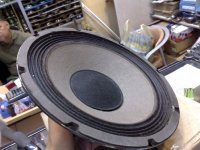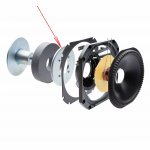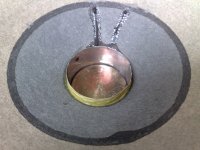I have lately received a pair of 10 inch vintage woofers. I was so surprised at their low freq. performance that I was tempted to use them as subwoofers for my current sound system.
They're not re-coned but the cone is still tough, along with healthy surrounds and spiders and powerful magnets that keep the motion linear even at slightly high volumes.
At powers as high as 30W the voice coil doesn't even get warm.( I removed the dust cap off one of them!)
The only problem here is that at high volumes some noises start to come out of the dust cap because of lack of air ventilation.
The dust cap is, however, made of flexible treated cloth that can somehow absorb the mid-bass shocks; but it fails at very low freq.
The question is should I make a hole in the pole piece or not? and, does doing so degrade the drivers' performance in any way?
And what about holes in the spider? Are there chances the spider will tear apart after some time?
And if anyone posts the drivers' brand I'll appreciate so much.
Some info on the drivers( may be useful):
Imp: 8 Ohms
Fs: 25Hz
Xmax:10mm
Maximum non-linear p-p excursion: 1"
Voice Coil Diameter: 1.5"
Cone breakup freq.: 1.3KHz
Square magnet
Pretty loose surrounds
Regards,
Ali
They're not re-coned but the cone is still tough, along with healthy surrounds and spiders and powerful magnets that keep the motion linear even at slightly high volumes.
At powers as high as 30W the voice coil doesn't even get warm.( I removed the dust cap off one of them!)
The only problem here is that at high volumes some noises start to come out of the dust cap because of lack of air ventilation.
The dust cap is, however, made of flexible treated cloth that can somehow absorb the mid-bass shocks; but it fails at very low freq.
The question is should I make a hole in the pole piece or not? and, does doing so degrade the drivers' performance in any way?
And what about holes in the spider? Are there chances the spider will tear apart after some time?
And if anyone posts the drivers' brand I'll appreciate so much.
Some info on the drivers( may be useful):
Imp: 8 Ohms
Fs: 25Hz
Xmax:10mm
Maximum non-linear p-p excursion: 1"
Voice Coil Diameter: 1.5"
Cone breakup freq.: 1.3KHz
Square magnet
Pretty loose surrounds
Regards,
Ali
Attachments
CTS is the brand, the part before is the model
I highly doubt they are capable of much more than 5mm, how are you specing xmax?
I highly doubt they are capable of much more than 5mm, how are you specing xmax?
On the photo it looks like the dustcap is not properly glued on anymore. Maybe that is causing the noises.
Dear Ron E, I just attached the drivers to my amp and cranked the volume up to the max! I'm not sure about its absolute linearity, but the drivers travel a healthy inch without any distortion, audible sound compression or excessive heat. I know it seems kind of wired for classic drivers like these.
Dear TBTL, The one in the pic is the one I removed the dust cap off. The other driver has its dust cap tight in place. I'm experienced enough to detect driver problems based on its output.
Thanks for replies.
Regards
Dear TBTL, The one in the pic is the one I removed the dust cap off. The other driver has its dust cap tight in place. I'm experienced enough to detect driver problems based on its output.
Thanks for replies.
Regards
I build a subwoofer with the 12-inch version of that driver back in 1978. Two twelves in a coffin down firing with slot around the bottom. It was great and the drivers hang in there well.Dear Ron E, I just attached the drivers to my amp and cranked the volume up to the max! I'm not sure about its absolute linearity, but the drivers travel a healthy inch without any distortion, audible sound compression or excessive heat. I know it seems kind of wired for classic drivers like these.
Dear TBTL, The one in the pic is the one I removed the dust cap off. The other driver has its dust cap tight in place. I'm experienced enough to detect driver problems based on its output.
Thanks for replies.
Regards
measure the thickness of the drivers top plate and divide that thickness by three, that number is very close to the drivers actual peak to peak linear travel. Motion greater than that becomes progressively more non linear as travel increases. The human ear is not very critical of low frequency distortion. This holds true for any dynamic driver you use.
I build a subwoofer with the 12-inch version of that driver back in 1978. Two twelves in a coffin down firing with slot around the bottom. It was great and the drivers hang in there well.
Subwoofers in a coffin? Bass can't be any creepier! Cool!
Dear Audiosys, Thanks for your info on the drivers.
Dear Moray, what is the top plate?
But the main question here is Whether or not increasing the amount of ventilation in the drivers affect the driver performance in any negative way.
All I know is that doing so will loosen the driver a little bit and shifts the Fs down, which doesn't seem a bad thing to me.
What type of Technique do you use to prevent contamination issues while machining the metal. Seems that particles would find their way into the magnetic path ?
Dear Art M, I have removed the dust cap. all I have to do is to seal the voice coil gap with duct tape and cover the drilling place with cotton. This way, most of the metal particles stuck to the cotton and the rest are removed with vacuum cleaner or hand. No particle can enter the gap until I unseal it.What type of Technique do you use to prevent contamination issues while machining the metal. Seems that particles would find their way into the magnetic path ?
Dear Dave, I post a video of the driver excursion. You be the judge!
Is there any other problem for this driver being a subwoofer?
Attachments
Sounds like a reasonable plan on paper, but executing it with 100% success rate is another thing altogether.Dear Art M, I have removed the dust cap. all I have to do is to seal the voice coil gap with duct tape and cover the drilling place with cotton. This way, most of the metal particles stuck to the cotton and the rest are removed with vacuum cleaner or hand. No particle can enter the gap until I unseal it.
What you will find is that the pole piece is going to get hot when you drill it, especially if your cutting bit is dull. That will cause the adhesive on the duct tape to soften and the tape will peel up letting metal particles into the gap. Unless you have a carbide bit or drill extremely slowly you are going to want to use oil or cutting fluid. That also will make the duct tape peel.
I've drilled pole pieces before and the best plan of attack is to assume that you will get some junk in the gap. Attempting to cover the gap just simply reduces the amount that gets in there so there is less clean up work to do later. I wouldn't bother drilling a woofer unless you are planning to recone it anyway. Just put a phase plug on the pole piece and/or a mesh dust cap.
The magnetic field in the gap of most speakers is very strong - especially on a big woofer. A household vacuum cleaner will probably not be very useful.
What you suggest is an excellent way to destroy your speakers, so if that´s your purpose, go ahead.
Plus you do NOT need a hole in the polepiece since the dust protection dome is made out of cloth anyway.
As of Xmax.
The cones may very well move back and forth 10 mm or so, just driven by inertia and the last few VC coil turns still immersed in the gap, that does not mean that such motion is linear.
1" each way? ..... please actually measure it instead of estimating.
Plus you do NOT need a hole in the polepiece since the dust protection dome is made out of cloth anyway.
As of Xmax.
The cones may very well move back and forth 10 mm or so, just driven by inertia and the last few VC coil turns still immersed in the gap, that does not mean that such motion is linear.
1" each way? ..... please actually measure it instead of estimating.
One idea to protect the magnetic gap from metal particle is to fill the hole space from inside of bobina with plasticine. The Plasticine will retain all particle generated during driling.
As of Xmax.
The cones may very well move back and forth 10 mm or so, just driven by inertia and the last few VC coil turns still immersed in the gap, that does not mean that such motion is linear.
1" each way? ..... please actually measure it instead of estimating.
I NEVER said "each way". I said peak to peak. And that's the maximum excursion, NOT maximum linear motion.
What you suggest is an excellent way to destroy your speakers, so if that´s your purpose, go ahead.
Plus you do NOT need a hole in the polepiece since the dust protection dome is made out of cloth anyway.
So you suggest not making hole in the pole piece. so what exactly should I do with the lack of ventilation? It's true the dust cap is made of cloth but it's sealed and flexes during long excursions, making extra noise and preventing the driver from moving linearly.
And what about making holes in the spider? Does it have any side effects?
So the dust cap is cloth but somehow sealed or impregnated with some thick stuff which blocks it?
Ok, get a couple cloth or non woven cloth caps and use them instead.
Out of the factory they are porous , unless soaked on purpose; in fact if blocked that might have been made by some user.
Glue them to the cone with water based carpenter´s PVA glue.
Ok, get a couple cloth or non woven cloth caps and use them instead.
Out of the factory they are porous , unless soaked on purpose; in fact if blocked that might have been made by some user.
Glue them to the cone with water based carpenter´s PVA glue.
Personally when i am using a driver with a vented pole piece i will block the hole.
In the video, the driver looks to be out of control.
dave
In the video, the driver looks to be out of control.
dave
FWIW I use vented pole pieces in my own speakers, but would never ever create any kind of iron chips anywhere near a voice coil gap, already have enough trouble with unexpected unseen ones.
I ask my lathe operator to drill polepieces while turning them; no big deal because he uses a multi tool lathe, it´s just an extra operation.
Besides cleaning with compressed air, IF any tiny chip remained, it would disappear during the plating operation which includes various boiling water stages, degreasing, pickling in acid, etc.
But on an already magnetized and assembled speaker ... forget it.
I ask my lathe operator to drill polepieces while turning them; no big deal because he uses a multi tool lathe, it´s just an extra operation.
Besides cleaning with compressed air, IF any tiny chip remained, it would disappear during the plating operation which includes various boiling water stages, degreasing, pickling in acid, etc.
But on an already magnetized and assembled speaker ... forget it.
- Status
- Not open for further replies.
- Home
- Loudspeakers
- Multi-Way
- Vintage Driver Ventilation Improvement



